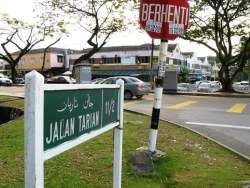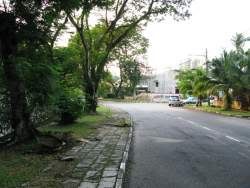

Jalan Tarian Aminulrasyid turned into fronts a bustling commercial lot with all-night restaurants.Aminulrasyid’s car crashed into the partially uprooted tree on the left before plunging into the drain
By most accounts there was nothing eye-catching about him. Not the way he spoke, how he ribbed his friends or how he dressed.
Aminulrasyid Amzah was quite simply a quiet, diminutive 14-year-old schoolboy, according to those who lived around him and who saw him last.
If he was part of your school-yard group, he would have been one of the followers. Not the one everyone bullied but certainly not the one with the zaniest jokes, the one who got all the girls’ phone numbers or the one who shaped opinions.
He is remembered as being a part of the many regular groups of schoolboys who roamed the neighbourhood after class. Who ate out with their families at the community’s food court and who haunted the cybercafés.
In essence, he was part of the scenery of Shah Alam’s Section 11. One of this Malay-Muslim city’s oldest neighbourhoods and which is known for its seamless mix of working class and upscale houses.
That is what has rankled many in Section 11 — that others are trying to force them to believe something which they feel they know as intimately as their backyards.
It is not just that his death is a tragedy; it is also the conflicting reports surrounding it.
What the authorities say happened on the day clashes with the accounts of eye-witnesses who saw the boy’s car being chased and peppered with bullets, and who saw how the wreck sat in the drain.
And then there is the part about him being called an armed robber.
According to those who saw him last that day and night, some of them who also saw the car chase, it would be a stretch to believe he was a hardcore criminal who had to be put down.
One resident, who attended the boy’s burial prayers and who knew the family, summarised the sentiment succinctly:
“This did not happen in some oil palm estate or some jungle. It happened in Section 11. People saw it and people here are not easily fooled”.
During the early years of Shah Alam, Section 11 was commonly and mistakenly known as an “elite” neighbourhood. There were just as many low-cost single storey and double terrace houses as there were bungalows. Other neighbourhoods had the same mix, but somehow the reputation stuck.
One reason may be its high population of civil servants, from clerks to director-generals, as the city is Selangor’s administrative capital. There are also clusters of homes belonging to senior Armed Forces and police officers.
A good one-third of those civil servants are lecturers in Universiti Institut Teknologi Mara (UiTM).
Till today, the mamak stalls at the middle of Section 11 are filled with knots of grey-haired pensioners sipping teh tarik and discussing everything from the New Economic Model to Sodomy II.
Essentially, it is a neighbourhood that not only reads all the newspapers, says a long-time resident, they routinely read between the lines because they themselves have worked in the ministries and agencies that are in the news.
Many of the old families, such as Aminulrasyid’s, eat at the same restaurants, go to the same surau and send their kids to the same schools, and this creates a loose network that gossips about things such as the alleged Najib-Muhyiddin rivalry or the Cabinet ministers’ wives.
So when they read in the papers that “a parang was found in Aminulrasyid’s car” red flags immediately go up. For these people, “finding a parang in the car” is a phrase they tend to associate with high-level deceit.
“I was at the surau for the burial prayers. Tell me, if he was really a criminal like how they say he was, how come there was a police motorcade that escorted the body to the cemetery?
“A police department cannot justify sending a motorcade to the funeral of a ‘criminal’,” says the resident, a well-known community leader.
Aminulrasyid was shot dead by policemen in the early hours of April 26 in the car he was driving.
According to reports, he had been chased by two patrol cars from Section 7 and was on his way home.
His friend, Azamuddin Omar, 15, who was in the passenger seat claims when a bullet hit Aminulrasyid in head, his foot was still on the accelerator and this forced the car to crash into a drain.
However, the policemen claimed Aminulrasyid tried to reverse the car into them and that was when they shot him. The policemen also claimed they found a parang in the vehicle.
Aminulrasyid’s family disputes this.
One of the community leader’s friends remarked that if, from the start, the government admitted that the shooting was an accident and that there would be reparations, there could have been more forgiveness.
Instead, in conversations about what happened, the “c” word is liberally used.
“Who do they think we are? We know what a ‘cover-up’ looks like. They contradict themselves. The whole neighbourhood feels this way”.
And they’re not afraid to let the authorities know, either. When the Home Ministry independent panel visited the crash site on Jalan Tarian, the community figure was there to offer them his two sen’s worth.
“There was even a couple who came out of their house, and together, we upbraided one of the members. The guy tried to unsuccessfully plug the government line but we told him off.
“We know the real story about the Anwar’s (Opposition leader Datuk Seri Anwar Ibrahim) trials and Altantunya (Shariibuu, the murdered Monogolian model). And this thing looks the same.
On his drive back home, Aminulrasyid turned into Jalan Tarian and headed to his house on Jalan Mak Yong.
Opposite that turn into Jalan Tarian, is Section 11’s eatery hub, which at 2am, is still doing roaring business.
The staff at two of its well-known restaurants can recount how they heard fire-cracker-like pops of gunfire that riddled the boy’s car, how they saw the car wobbling after all the tyres were shot out and how it was stuck in the drain after it crashed.
“It wasn’t a high speed chase. The boy’s car seemed to be cruising at maybe 60kph and the police car was right behind his, firing at the car,” says a waiter at one of the restaurants who witnessed the incident.
Coincidentally, these eateries are frequented by the families of Section 11 and the ex-director-generals, lecturers, and surau figures who shape collective opinion in the neighbourhood.
The intellectual inclination of the latter to speculate — combined with the accounts of these waiters, cooks and cashiers — creates the entrenched view that the government is not, and some say will not, come clean about the incident.
These eateries are where Aminulrasyid is seen every day. Either “lepakking” with his pals or having dinner with his mother and siblings.
The staff and the owners of the restaurant even know that Aminulrasyid’s father died of a heart attack some years back, that the family keeps to themselves but whose members seem close.


The familiarity in this case between the eatery and the family breeds a sense of togetherness, like he was part of the place.
It probably explains why the waiters, owners and customers of these eateries can appear unconcerned about the fact that a boy his age was out at such a late hour.
Even some of the elders The Malaysian Insider spoke to pooh-poohed the notion that teens should be home at a certain hour.
“So what if they were out late? They aren’t bad boys. They’re not Mat Rempit. They were just watching football,” says one elderly resident and ex-civil servant.
The same ex-civil servant explained that one cannot compare Shah Alam to Petaling Jaya or Kuala Lumpur. There are no pimps, there are no prostitutes and you will not see drug peddlers walking the streets. The women generally wear clothes that cover everything from their wrists to their ankles.
There are no cinemas, pubs, bars or karaoke joints. The Mat Rempits of Shah Alam are mostly harmless UiTM students, not the packs of hopped-up fiends that terrorise the roads of KL.
It is probably because the city is so drab that parents are lulled into thinking that it is alright for their teens to be out late.
“There are no troubled teens here in Section 11. ‘Semua terkawal’ (everything is under control),” says Abdullah Md Ali, chairman of the Seksyen 11 surau.
Though emotions are still raw in Section 11, the surau committee official says that after 100 days, many would have forgotten the incident.
“I’m not being mean, it’s just the nature of things. The 100-day rule.”
In a busy neighbourhood such as Section 11, it is hard not to agree with him as a hectic urban lifestyle tends to ensure that events get steamrolled over by newer events.
In a way, this pace hides a dilemma about Section 11. It is that modern Malaysian problem of trying to strike a balance between that almost too-close vigilance of the old Malaysian village and the shuttered privacy of the city.
Shah Alam’s Malays, after all, grew up in villages where neighbours would look out for each other’s children and a wayward kid seldom escapes notice.
Yet the Malays who grew up in such an environment feel awkward about practising the same sort of vigilance in a residential area such as Section 11.
“I had wanted to say something about Aminulrasyid hanging out late at night to his mother.
“But I didn’t know how to put it. I was afraid she might take it wrongly. That I ‘jaga tepi kain’ (being a busybody)
“So I didn’t say anything,” says one of the boy’s closest neighbours, who frequently saw him return home well after dark.
The matronly woman cannot help believing that things could have turned out differently if only someone spoke up about the boy’s late night habits.
She is quick to add that the way the cops acted that night was also not right.
“I don’t want to say anything or judge anyone. It’s not my place. I’m just saying that it’s hard when you can’t ‘tegur’ (admonish) but it’s not right not to care (about one’s neighbours) either.”


